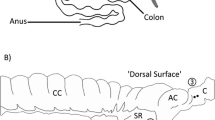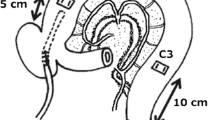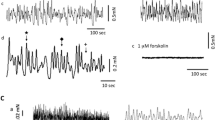Abstract
To better define the physiologic relevance of the cholinergic muscarinic input to the rabbit colon and the role of different muscarinic receptor subtypes, we studied the effects of atropine, telenzepine (M1 antagonist) and DF594 (M3 antagonist) on colonic motility in eight conscious rabbits fitted with bipolar electrodes and strain gauges along the proximal colon. In some experiments, the chronotropic and mydriatic effect of the pharmacological agents were also assessed. Two main patterns of spike activity were identified: short spike bursts (SSBs), which were usually stationary, and long spike bursts (LSBs), which were usually propagated. Both myoelectrical patterns were dose-dependently inhibited by atropine (0.06–4 μmol/kg). Atropine, at the doses of 2–4 μmol/kg, abolished both myoelectrical and mechanical activity. Telenzepine (0.008–0.125 μmol/kg) dose-dependently inhibited migrating LSBs without significant effect on SSBs. Higher doses (0.25–0.5 μmol/kg) inhibited both LSBs and SSBs. DF594 (0.06–2 μmol/kg) dose-dependently inhibited both migrating LSBs and SSBs. The three antimuscarinic agents, at doses that inhibited colonic spike activity by approximately 80% (equiactive doses), behaved as follows on heart rate and pupil diameter: atropine induced tachycardia and mydriasis, telenzepine had no effect, and DF594 induced slight mydriasis with no effect on heart rate. We conclude that spontaneous motility in the rabbit proximal colon depends on a muscarinic excitatory input. M3 receptors are involved in the control of both LSBs and SSBs, while M1 receptors play an important role in the regulation of LSBs. The development of selective antimuscarinic drugs, acting on a given motility pattern and with minimal side effects, may offer new perspectives in the treatment of functional bowel motor disorders.
Similar content being viewed by others
References
Doods HN, Mathy MJ, Davidesko D, Van Charldorp KJ, De Jonge A, Van Zwieten PA: Selectivity of muscarinic antagonists in radioligand andin vivo experiments for the putative M1, M2 and M3 receptors. J Pharmacol Exp Ther 242:257–262, 1987
Subtypes of muscarinic receptors IV. Proceedings of the Fourth International Symposium on Subtypes of Muscarinic Receptors. July 20–22, 1989, Wiesbaden, Germany, RR Levine, NJM Birdsall (eds). Trends Pharmacol Sci 10:1–96, 1989, December Supplement
Goyal RK: Muscarinic receptor subtypes. Physiology and clinical implications. N Engl J Med 321:1022–1029, 1989
Christensen J: Motility of the colon.In Physiology of the Gastrointestinal Tract. LR Johnson (ed). New York, Raven Press, 1987, pp 665–693
Eltze M, Gönne S, Riedel R, Schlotke B, Schudt C, Simon WA: Pharmacological evidence for selective inhibition of gastric acid secretion by telenzepine, a new antimuscarinic drug. Eur J Pharmacol 112:211–224, 1985
Schudt C, Auriga C, Kinder B, Birdsall NJM: The binding of [3H]telenzepine to muscarinic acetylcholine receptors in calf forebrain. Eur J Pharmacol 145:87–90, 1988
Lavezzo A, Caselli GF, Bestetti A, Ferrari MP, Borsa M, Tonon GC: Spasmolytic and antiulcer activities of a new series of antimuscarinic compounds. Pharmacol Res Commun 20(suppl 2):201, 1988
Fioramonti J, Garcia-Villar R, Bueno L, Ruckebush Y: Colonic myoelectrical activity and propulsion in the dog. Dig Dis Sci 25:641–646, 1980
De Ponti F, Bonabello A, D'Angelo L, Frigo GM, Crema A: Quantitative analysis of intestinal electrical spike activity by a new computerized method. Int J Bio-Med Comput 22:51–64, 1988
Tallarida RJ, Murray RB: Manual of Pharmacologic Calculations with Computer Programs, 2nd ed. New York, Springer, 1987
Snape WJ, Shiff S: Neurohumoral control of colonic motility in the rabbit. Am J Physiol 245:G582-G588, 1983
Cannon WB: The movements of the intestines studied by means of the Röntgen rays. Am J Physiol 6:251–277, 1902
Tonini M, Lecchini S, Frigo GM, Crema A: Action of tetrodotoxin on spontaneous electrical activity of some smooth muscle preparations. Eur J Pharmacol 29:236–240, 1974
Mackenna BR, McKirdy HC: Peristalsis in the rabbit distal colon. J Physiol (London) 220:33–54, 1972
Anuras S: Electromyogram of rabbit colon and cecum in vitro. J Lab Clin Med 98(6):896–905, 1981
Snape WJ, Kim BH, Willenbucher R, Koelbel CB, Maier EA Jr, Walsh JH: Differences in the response of proximal and distal rabbit colonic muscle after electrical field stimulation. Gastroenterology 96:321–326, 1989
Schwörer H, Kilbinger H: Enhancement of guinea-pig intestinal peristalsis by blockade of muscarinic M1-receptors. Br J Pharmacol 93:715–720, 1988
Schiavone A, Sagrada A, Pagani F, Giachetti A: Role of muscarinic receptor subtypes in the regulation of migrating myoelectric complex in the dog. Gastroenterology 96:116–121, 1989
De Ponti F, Einaudi A, D'Angelo L, Lecchini S, Frigo GM, Crema A: Regulation of intestinal motility by different muscarinic receptor subtypes. Eur J Pharmacol 183:2191, 1990
Micheletti R, Schiavone A, Giachetti A: Muscarinic M1 receptors stimulate a nonadrenergic noncholinergic inhibitory pathway in the isolated rat duodenum. J Pharmacol Exp Ther 244:680–684, 1988
Schiavone A, Sagrada A, Micheletti R, Giachetti A: Pharmacological characterization of muscarinic receptors involved in McN-A-343-induced effects on intestinal motility and heart rate in conscious dogs. Br J Pharmacol 94:566–572, 1988
Nowak TV, Harrington B, Kalbfleisch JH: Evidence for muscarinic inhibitory neurotransmission in rodent small intestine. J Pharmacol Exp Ther 248:573–580, 1989
Furness JB, Costa M: The Enteric Nervous System. Edinburgh, Churchill Livingstone, 1987
Dapoigny M, Trolese JF, Bommelaer G, Tournut R: Comparison between the effects of atropine and pirenzepine on colonic motility: electromyographic study in irritable bowel syndrome. Hepato-Gastronterol 35:188, 1988
Christofi FL, Palmer JM, Wood JD: Neuropharmacology of the muscarinic antagonist telenzepine in myenteric ganglia of the guinea-pig small intestine. Eur J Pharmacol 195:333–339, 1991
North RA, Slack BE, Suprenant A: Muscarinic M1 and M2 receptors mediate depolarization and presynaptic inhibition in guinea-pig enteric nervous system. J Physiol (London) 368:435–452, 1985
Kilbinger H, Nafziger M: Two types of neuronal muscarine receptors modulating acetylcholine release from guinea-pig myenteric plexus. Naunyn-Schmiedeberg's Arch Pharmacol 328:304–309, 1985
Christensen J, Anuras S, Hauser RL: Migrating spike bursts and electrical slow waves in the cat colon: Effect of sectioning. Gastroenterology 66:240–247, 1974
Barocelli E, Morini G, Ballabeni V, Lavezzo A, Impicciatore M: Effects of two new pirenzepine analogs on the contractile response of the guinea-pig oesophageal muscularis mucosae to acetylcholine, bethanechol, histamine and high potassium. Eur J Pharmacol 179:89–96, 1990
Bueno L, Fioramonti J, Ruckebush Y, Frexinos J, Coulom P: Evaluation of colonic myoelectrical activity in health and functional disorders. Gut 21:480–485, 1980
Frexinos J, Fioramonti J, Bueno L: Colonic myoelectrical activity in IBS painless diarrhoea. Gut 28:1613–1618, 1987
Bognar IT, Wesner MT, Fuder H: Muscarine receptor types mediating autoinhibition of acetylcholine release and sphincter contraction in the guinea-pig iris. Naunyn-Schmiedeberg's Arch Pharmacol 341:22–29, 1990
Patil PN: Some factors which affect the ocular drug responses. Trends Pharmacol Sci 5:201–204, 1984
Author information
Authors and Affiliations
Additional information
This work was supported in part by a grant from the Ministero dell'Università e della Ricerca Scientifica e Tecnologica.
Rights and permissions
About this article
Cite this article
Cosentino, M., De Ponti, F., D'Angelo, L. et al. Motility of rabbit proximal colon. Digest Dis Sci 37, 1746–1753 (1992). https://doi.org/10.1007/BF01299869
Received:
Revised:
Accepted:
Issue Date:
DOI: https://doi.org/10.1007/BF01299869




